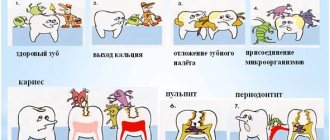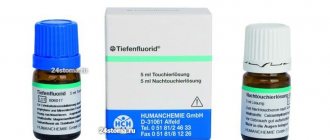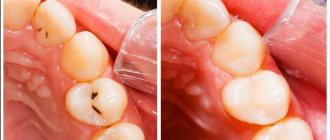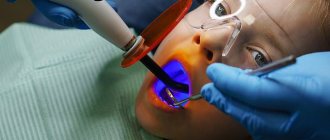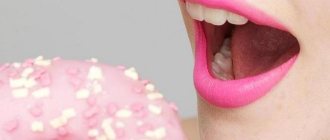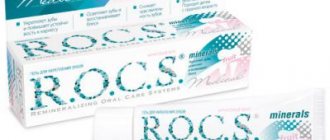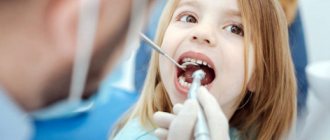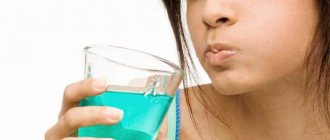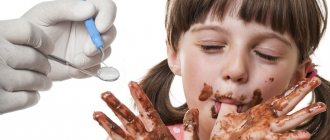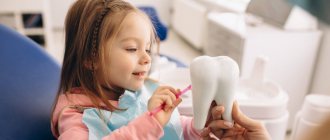From this article you will learn:
- how to properly care for your teeth,
- what is the best way to brush your teeth,
- how to protect teeth from caries.
The development of caries occurs with the participation of cariogenic bacteria in the oral cavity, which metabolize food debris stuck between the teeth after eating, turning them into lactic acid.
The acid dissolves the surface layer of tooth enamel, initially leading to the appearance of white chalky spots, which are the most initial, yet reversible, form of caries. White spots on human teeth are symptoms of the appearance of foci of demineralization of tooth enamel, in which acid has dissolved a significant part of the minerals (hydroxyapatite). If the acid attack continues for a long time, then the demineralization process reaches such a degree that the density of the enamel not only decreases, but its structural destruction occurs - a carious tooth defect is formed. The latter can be cured only by filling the tooth.
Thus, the main role in the development of caries is played by 1) microbial plaque, 2) food debris. Good regular oral hygiene can remove both of these components from teeth, but it is also important to avoid constant snacking between meals and frequent consumption of sugar-sweetened drinks. Therefore, if you are asking yourself how to get rid of tooth decay, then proper regular oral hygiene is the most important part of protecting your teeth from tooth decay and gum disease. And below we will tell you what it should be.
Important: dental care may include not only regular teeth brushing, but also additional measures that will help you strengthen your tooth enamel even more effectively. For example, the risk of developing caries can be further reduced by remineralizing teeth (we are talking about professional and home fluoridation of teeth). And we will also talk about all this in detail below.
Stopping the development of caries
It is advisable to stop the development of caries at the earliest possible stage: in this case, the disease will be much easier to treat.
At the initial stage, caries looks like a small spot. At this stage of development, it can be coated with a special gel that can restore damaged enamel. If you see a doctor on time, you may be able to do without the preparation procedure, which is, of course, completely painless.
If you start the development of caries, you will have to resort to drilling, and if the pulp is affected, this can add additional painful sensations.
In addition, ignoring caries is fraught with:
- destruction of the affected tooth and, as a result, expensive installation of an implant;
- indigestion, since the affected teeth cannot fully cope with the chewing function;
- aesthetic inconveniences.
There are also separate types of caries:
- Cervical caries.
Tooth damage occurs in the neck of the tooth. Treatment is complicated by the proximity of the gums to the site of inflammation.
- Milk caries.
This disease can develop on children's baby teeth as a result of insufficient hygiene and care of the teeth and oral cavity. Children's teeth are easily exposed to bacteria, especially if the child consumes foods high in carbohydrates: sweets, carbonated drinks. Some parents do not attach much importance to the disease of baby teeth, believing that there is no need to treat teeth that will soon be replaced by permanent ones. However, one should take into account the fact that milk caries is a source of bacteria that can provoke diseases of the ENT organs, the digestive system, and also provoke infection during the eruption of permanent teeth.
Prevention of caries: local methods
These methods of preventing caries include:
- Remineralization is a procedure during which tooth enamel is saturated with fluoride and calcium, which has a positive effect on its strength. In addition, fluoride prophylaxis increases the resistance of enamel to microorganisms that provoke the development of caries.
When acidity drops below pH5, the concentration of calcium and a number of other elements in tooth enamel begins to rapidly decrease. It is at this moment that the greatest activity of cariogenic organisms is observed. After covering the tooth surface with fluoride varnish, fluorine begins to penetrate into the enamel, which, together with calcium, does not allow it to dissolve even in conditions of high acidity.
Remineralization can be:
- Homemade, which consists of the most ordinary thorough brushing of teeth with toothpastes containing fluoride. There are pastes with more effective amino fluoride (they have a higher price and a faster penetration rate of fluoride into the enamel), as well as with sodium monofluorophosphate (they are a budget option). For a more professional fluoride prophylactic course, in addition to toothpastes and rinses, you will need remineralizing gels, which need to be used every 3-4 months, which does not replace brushing your teeth. If you follow these rules throughout your life, there's a good chance you'll never have to treat tooth decay.
- Professional , for which you cannot do without visiting a doctor. Its main advantage is better efficiency due to the use of drugs characterized by a higher concentration of active substances. During the procedure, the teeth are coated with a transparent fluoride-containing varnish, which actively penetrates the enamel over the course of several hours. Gradually the film dissolves.
WHO recommends fluoride prophylaxis in two ways: using fluoride pastes at home and periodically resorting to the use of professional preparations that modern dentistry can offer.
- Proper oral hygiene , which is both a simple and very important step in caries prevention, prevents the appearance of carious areas.
A considerable part of people believe that their oral hygiene is absolutely fine. However, if this were true, the disease would not be so common.
Professional dental treatment with fluoride –
At the beginning of the article, we already told you that the initial stage of caries develops due to exposure to acid secreted by cariogenic bacteria. This acid dissolves the surface layer of enamel - as a result of which the enamel loses calcium, i.e. demineralization of the enamel occurs. However, there are therapeutic measures that can strengthen tooth enamel by saturating it with minerals (fluorine and calcium). This process is called tooth remineralization.
Remineralization is not only professional (carried out in a dental office), but it can also be easily done independently using the right quality products. At home, you constantly use toothpastes with fluoride or calcium, which also contribute to the remineralization of tooth enamel, despite moderate concentrations of active ingredients. To strengthen enamel in children and adults, dentists most often use the method of professional fluoridation of teeth (using highly concentrated varnishes and gels).
Professional fluoridation of teeth is more effective compared to fluoride-containing therapeutic and prophylactic toothpastes. For example, the fluoride concentration in dental varnish is usually 22,600 ppm, and conventional dental toothpastes contain a maximum of 1,450 ppm of fluoride. And in Colgate® Duraphat medicinal pastes (which we described above) – 2800 or 5000 ppm.
In what cases is it better to choose fluoride treatment of teeth at the dentist, and in what cases is it better to use medicated toothpastes with a high dosage of fluoride at home? Read the article on fluoridation of teeth (see link above). But in general, the recommendations of the World Health Organization (WHO) recommend that fluoride prevention of caries should include both directions: firstly, the constant use of low doses of fluorides at home, and secondly, periodic professional applications of high doses of fluorides at the dentist (1 time in 3- 6 months).
The mechanism of action of fluorides (explanations below the picture) –
- Demineralization - when the pH of the oral fluid drops to pH 5.5 (i.e. becomes acidic) - the surface layer of enamel begins to dissolve and lose calcium and other trace elements. This is the starting point for the development of caries. A pH below 5.5 means an acidic environment, which is formed in the oral cavity under the influence of cariogenic microorganisms that “digest” food debris into organic acids.
- Remineralization - the surface of the tooth is coated with fluoride varnish, which promotes the formation of a layer of calcium fluoride (CaF2) on the surface of the tooth, from which calcium and fluoride ions penetrate into the enamel surface. There, fluoride ions bind to hydroxyapatite (the substance from which enamel is made), turning it into fluorohydroxyapatite. The latter is much more resistant to acid, and its dissolution begins only at pH 4.5 (i.e. at a higher acid concentration in the oral cavity). This ensures the anti-caries effect of fluorides.
How to prevent tooth decay
- Regular brushing of teeth (preferably after every meal). Moreover, you should brush your teeth not an hour or two, but within 5 minutes after eating. It has been proven that food debris and pathogens cause maximum harm to teeth in the first 40 minutes. Is it necessary to brush your teeth after every meal, that is, even after a light snack or tea with candy? Yes, it is necessary, and you need to clearly understand this for yourself. Therefore, you should not overuse snacks during the day.
- Dental floss - This is not an additional tool for cleaning the oral cavity, but is as basic as a toothbrush. Floss must be used in the same way after each meal. For a person who has never used floss before, it may be difficult to understand how to use it - a dentist can help with this. The task of dental floss is to remove food debris between the teeth (caries, no less rarely, develops not only in the tooth cavity, but also between two adjacent teeth).
- What to do if brushing your teeth is problematic (for example, in a cafe or outdoors)? You should always have dental floss or, as a last resort, chewing gum with you. A package of thread does not take up much space, and you can use it by going to the toilet (if we are talking about a room) or stepping aside. Many people are embarrassed to behave this way, as a result, subsequently they will not always have simple and cheap treatment for caries. Embarrassment is inappropriate here: there is nothing shameful in getting up and going to the restroom for a couple of minutes. It’s much better to breathe in freshness afterwards, rather than “delight” those around you with the aromas of a recently eaten lunch.
- Food debris often accumulates under dentures and braces.. People who have crowns in their mouths can be advised to use an irrigator - a device that delivers a stream of water through a special nozzle, saturated with air bubbles and washing away food debris. The device is especially effective for gingivitis and periodontitis, when pockets form where a large number of microbes accumulate. Periodontal pockets are very difficult to clean with a brush or floss, but an irrigator can cope with this task perfectly. The device is also recommended for pregnant women, who often suffer from gingivitis.
In addition to brushing and flossing, the following can help prevent tooth decay:
- strengthening the immune system. A weakened body is not able to fully resist the effects of bacteria. To minimize the risk of developing caries, subject to good hygiene, you need to take care of your immunity through the use of vitamins and hardening;
- properly formulated diet. First of all, you need to reduce the consumption of simple carbohydrates, and also increase the amount of foods containing fluoride and calcium in the menu. We must not forget about regular consumption of hard fruits and vegetables, which cleanse teeth of plaque.
Seal your child’s teeth from caries: how fissure sealing is carried out
Fissure sealing is a painless and short procedure. To carry it out, a “sealant” material, a fissure sealant, is used. Sealant is a high-strength composite composition that hardens under the influence of light. Its feature is increased fluidity, thanks to which the sealant is able to fill even hard-to-reach places on the tooth crown. Also among the advantages of the sealant:
- Waterproof – resistant to saliva.
- Durability – the coating lasts on the teeth for up to 5 years.
- Aesthetics - sealants are produced in transparent, beige, and colored.
Stages of fissure sealing of primary and permanent teeth:
- Removing plaque from enamel and all cavities. Polishing the crown surface.
- Treatment with an antiseptic composition.
- Drying teeth and protecting the treated unit from the influence of saliva.
- Application of acid gel to enhance adhesion and create a slightly rough surface.
- Rinse off the composition and dry the tooth.
- Filling fissures with liquid sealant - applying sealant.
- Creating conditions for hardening - chemical activation or using a light lamp.
- Removing excess material.
- Coating the tooth with a fluoride-containing strengthening gel.
The optimal age of a child for fissure sealing is 6-8 years. During this period, the first permanent molars erupt and need protection. The procedure is indicated for children aged 1.5-2 years, and adolescents aged 12-14 years. The appearance of any wide tooth is a reason to carry out dental sealing and reliably protect the enamel from destruction for several years.
Plaksina Margarita
I am often asked what they cover children's teeth with to protect them from caries. At Aza&Buka we use sealants - special gels. They not only seal the surface of the tooth, but also strengthen the enamel by releasing fluoride ions.
Caries: general methods of prevention
- The main reason for the development of caries is carbohydrates consumed during meals (simple carbohydrates, i.e. sugars, are especially harmful). As a rule, a person consumes these elements between main meals (for example, drinking tea with sugar or confectionery). If you give up snacking, you will reduce the risk of developing caries.
- The use of vitamins that prevent the development of caries. In Russia, this method is not very common, although the anti-caries effect of vitamins B6 and B1 has long been proven. However, no pill, even taken on a regular basis, can prevent tooth decay if oral hygiene suffers.
- Fluoridation. This method of caries prevention helps strengthen the strength of enamel, increase its resistance to acid, and also get rid of the pain reaction to eating too hot or cold food. In simple fluoridation, fluoride gel is applied to the tooth. Deep fluoridation involves sealing the enamel. This is a longer process in which the teeth are first dried, then deep fluoride is applied to them, followed by drying again and the use of copper-calcium hydroxide.
- Infiltration. With this method of preventing dental caries, the stain is lubricated with an etching composition, then a drug that seals the pores is applied to the cleaned surface of the tooth. Infiltration allows you to stop the development of caries and the increase in the size of the carious spot, since the acid released by bacteria is not able to penetrate into the enamel. The method is absolutely painless, therefore it is recommended, including for children. The only condition for successful completion of the procedure is sitting still for 20 minutes, so infiltration may not be suitable for restless children.
- Ozone therapy.
- Laser therapy.
If a hole has already appeared in the tooth, then the above prevention options will not help: you will have to resort to surgical intervention.
The role of nutrition in preventing dental caries
One of the effective measures to combat caries is the correct approach to nutrition. The tissues of the oral cavity are sensitive to the lack of certain food components. In particular, a lack of protein in the diet prevents the accumulation of calcium and disrupts the structure and strength of enamel. At the same time, foods that are too fatty increase the permeability of the enamel, which increases the likelihood of the formation of carious lesions.
An excess of refined carbohydrates (sweets, flour products, sugar) in the diet not only reduces the resistance of teeth to the development of caries, but also weakens the immune defense, which is also a risk factor.
To prevent caries, it is important to adhere to the following dietary recommendations:
- A sufficient amount of protein must be present in the daily diet;
- eat foods containing vitamins C, D and group B;
- be sure to eat foods rich in calcium and phosphorus (milk, cheese, eggs, fish, broccoli, legumes), as well as fluoride-containing foods (sea fish, Georgian tea);
- it is necessary to limit the consumption of foods rich in “fast” carbohydrates, eat as little sweets, cakes and refined sugar as possible;
- Avoid sticky products: they can remain on the surface of tooth enamel for up to an hour, contributing to its demineralization for a long time.
The nature of your diet directly affects the condition of your teeth. A rational, fortified, balanced diet is an effective method of non-drug prevention of caries.
Dental caries in children
In children, identifying caries is quite simple: first, white or brown spots appear on the teeth, then the teeth begin to react to hot or cold food, and bad breath may appear. All these symptoms indicate the rapid development of the disease. If action is not taken in time, the infection can spread to several teeth at once.
Causes of caries development in children:
- The main cause of childhood caries is poor oral hygiene. The task of parents is to choose the right toothbrush for their child and teach him how to brush his teeth. Many young children are afraid of this harmless procedure, so we can recommend trying to present brushing as a game. It is necessary to accustom a child to brush independently starting from the age of 3 (before this moment, parents should brush the child’s gums and teeth).
- The infection can be transmitted from an adult to a child. As a rule, this happens if you eat with a child with the same spoon or kiss him on the lips, which is often abused by adults who are unable to cope with an overabundance of feelings.
- Genetic characteristics associated with abnormal maternal lifestyle during pregnancy. Teeth form during the first trimester, so if a woman smokes or drinks alcohol, this can affect the baby's dental development.
- Early caries, which appears in children before the age of 2 years, can be caused by poor mineralization of baby teeth.
- Various chronic diseases can also cause cavities.
- In infants, bottle tooth decay often occurs when the child eats food before bed. After eating, food residues remain on the teeth, and parents, instead of brushing the child’s teeth, put him to bed.
Reviewing your diet to maintain dental health
Products harmful to teeth
- Coffee and tea, without which not a single morning or working day can be completed. The caffeine contained
in these products makes tooth enamel loose, and it loses its protective properties. - Sugar and sweet foods, which are especially abused by children. After each meal completed with a sweet table, be sure to rinse your mouth so that food particles melt and do not remain between your teeth.
- Dairy products - the plaque formed after their consumption can destroy tooth enamel, despite the calcium content, which is beneficial for dental tissue. Rinsing will also help here, especially if you drank or ate something dairy before bed.
In addition, too hot or very cold foods are extremely harmful, especially if consumed one after another. Temperature changes negatively affect tooth enamel and contribute to its destruction, especially when there are microcracks in it.
Please note: all of the above rules are relevant not only for adults, but also for children. As soon as the child starts eating solid foods, he should be taught good oral hygiene and reminded to rinse his mouth after every meal. And try not to spoil your baby with sweets - even strong teeth will not withstand the aggressive effects of sugar and will quickly begin to decay.
Foods good for dental health
Among the obvious leaders are cottage cheese, cheese, spinach and beans, the substances they contain can have the most positive effect on the condition of the enamel and dental tissue. Fish and seafood are also very useful, known for their positive effects on various organs and tissues of the human body. To clean your teeth, it is recommended to eat nuts, hard fresh vegetables and fruits. They will bring many times more benefits than popular confectionery products.
For babies who are teething, doctors recommend preparing calcined cottage cheese. It is not difficult to obtain - when preparing a product from milk, simply add chlorinated calcium to the mixture, having first checked the recipe with your pediatrician. It will not affect the taste of the finished dish, but the calcium content in the cottage cheese will increase significantly, and the child’s teeth will grow faster and will pleasantly surprise children’s doctors with their impeccable health.
Dental health as an indicator of body condition
Is the condition of teeth related to human health? Numerous studies have proven a direct relationship between these aspects. Thus, several hundred years ago, during the dark periods of medieval slavery and serfdom, the health of hired workers and purchased servants was checked precisely by the condition of their teeth, and this diagnostic method was no less effective than modern ultrasound and tomography. So, if you have low immunity, diseases of the digestive system, metabolic disorders, all this will immediately affect the condition and appearance of the dentition. Therefore, the first signs of any dental illness are a surefire reason to put things off and undergo a comprehensive examination of the body in order to not only eliminate the consequence, but also to identify the cause of persistent dental problems.
How to keep your teeth healthy and strong? Traditional medicine tips
People's experience has accumulated a lot of valuable advice on maintaining dental health. These recommendations are still relevant today, despite the abundance of official medicine.
- Use a mixture of honey and salt (1 tablespoon and 0.5 teaspoon, respectively) as a massage mixture to treat gums. Very soon they will stop bleeding, and the teeth will not wobble in their sockets.
- Lemon, horsetail and black radish will help you cope with tartar. The substances contained in these products destroy and soften tartar, facilitating its removal.
- Black stripes along the edges of the teeth are a dubious decoration that can be easily gotten rid of. Bean husks and burdock root will help you. A strong decoction based on these substances must be used as a rinse several times a day, and the result will not be long in coming.
- A mixture of calamus and propolis tinctures will do an excellent job of strengthening enamel. Long-term rinsing of the mouth with this mixture will help quickly restore teeth and gums.
- Oak bark will help in the fight against inflammation and ulcers on the mucous membrane. Rinsing before bed will relieve redness, fight infection and remove odor, even if you smoke excessively.
However, remember that traditional medicine is not suitable for everyone, and their effectiveness has not been proven by experts. Do not neglect the problem in search of optimal treatment; use professional products from the ASEPTA line.
conclusions
There is a clear algorithm, following which, with a high degree of probability, you will never encounter the problem of caries.
- Regular removal of plaque and tartar is the key to healthy teeth . Good oral hygiene is the best cure for any disease related to teeth and gums.
- Proper diet . It is necessary to compose the daily menu in such a way that it contains as little flour and sweets as possible (food consisting mainly of easily digestible carbohydrates). It is also worth giving up sugary drinks (soda contains an extremely large amount of sugar). By avoiding sugary snacks, you can minimize your risk of tooth decay.
- Measures that increase the resistance of enamel to acids produced by pathogenic microorganisms should be carried out several times a year.
Consequences
Untimely treatment of caries can lead not only to dental disease, but also to other disorders of the body:
- disorders in the immune system caused by bacteria and leading to frequent acute respiratory viral infections;
- development of various types of allergies;
- violation of the digestive system, with manifestations in the form of heartburn, the development of gastritis;
- disruption of the cardiovascular system caused by the penetration of bacteria into the circulatory system during advanced tooth damage.
In addition, we should not forget that an untreated tooth can lead to its complete destruction and removal, disrupting the aesthetic appearance and causing complexes.
Cleanliness is the key to health
You need to brush your teeth twice a day: in the morning, after breakfast, and at night. This is done with vertical movements - the lower teeth are brushed from bottom to top, and the upper teeth from top to bottom. It is necessary to thoroughly clean not only the external, but also the internal surfaces of the teeth. And also the tongue - this can be done with a special brush or an ordinary spoon. It is better to have two toothbrushes: one to use in the morning, the other in the evening. The stiffness of the bristles of this hygienic device depends on the condition of the tooth enamel (it’s best to have your dentist evaluate this). People with sensitive enamel should use a brush with soft bristles and replace it with a new one every 2-4 months. And of course, keeping the toothbrushes of all family members in one glass is unhygienic (they should not touch each other).
A good invention is dental floss; it will help clean hard-to-reach corners of the mouth that a regular brush cannot reach. A special device - an irrigator - will do this even better and safer: it will simply wash away all contaminants with water under pressure. Dental elixirs are also a great thing: they have an antibacterial effect, strengthen gums, and freshen breath. You can use ready-made ones, or you can make your own: an infusion of sage, chamomile, or a decoction of oak bark will do. You shouldn’t write off rinsing your mouth after eating and eating sugar-free gum.
Thread, brush, irrigator. How not to harm your own teeth Read more
How to brush your teeth correctly
Choosing a toothpaste can be much more difficult than it seems. since there is a large choice, and each manufacturer proves in advertising that its paste is better, so it is difficult for an ordinary person not to get confused. Therefore, you need to choose a toothpaste with a cool head, and look not at the brand, but at the composition. The paste, which has a preventive effect, may contain compounds of fluorine, calcium, phosphorus, etc.
Flossing is a good way to clean spaces between teeth that a toothbrush cannot reach. A properly carried out process of cleaning the spaces between teeth takes 20-30 minutes. Although this procedure requires quite a lot of time, it is a good prevention of interdental caries.
